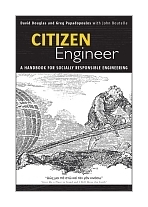|
||
• wydawnictwa polskie
• Zamów informacje o nowościach z wybranego tematu • kontakt
• Cookies na stronie |
CITIZEN ENGINNER: A HANDBOOK FOR SOCIALLY RESPONSIBLE ENGINEERINGDOUGLAS D. PAPADOPULOS G. BOUTELLE J.wydawnictwo: PEARSON ED , rok wydania 2009, wydanie Icena netto: Being an engineer today means being far more than an engineer. You need to consider not only the design requirements of your projects but the full impact of your work—from an ecological perspective, an intellectual property perspective, a business perspective, and a sociological perspective. And you must coordinate your efforts with many other engineers, sometimes hundreds of them. In short, we’ve entered an age that demands socially responsible engineering on a whole new scale: The era of the Citizen Engineer.
This engaging and thought-provoking book, written by computer industry luminaries David Douglas and Greg Papadopoulos, focuses on two topics that are becoming vitally important in the day-to-day work of engineers: eco engineering and intellectual property (IP). Citizen Engineer also examines how and why the world of engineering has changed, and provides practical advice to help engineers of all types master the new era and start thinking like Citizen Engineers. Table of Contents
Preface xv Acknowledgments xix About the Authors xxi Introduction: While You Were Busy Debugging… xxiii
Part I: Advent of the Citizen Engineer 1
Chapter 1: “Citizen Engineer” Defined 5 Responsibilities of the Citizen Engineer 7 Knowledge Base of the Citizen Engineer 8
Chapter 2: How Engineering Got Its Paradigm Shifted 13 Changes in the Nature of Engineering 13 Engineering on a Whole New Scale 13 Externally Driven Changes in Engineering 19 Perspectives on an Engineering Transformation 24 Part I Summary, and What’s Next 25
Part II: Environmental Responsibility 27
Chapter 3: Environmental Impact: The Big Picture 31 Eco-Responsible Engineering: An Enormous Opportunity 32 Core Challenges of Eco-Engineering 34
Chapter 4: Beyond the Black Cloud: Looking at Lifecycles 37 The “Cradle to Cradle” Vision 40
Chapter 5: A Pragmatic Approach to Lifecycle Analysis 45 A Basic Lifecycle Model 45 Additional Lifecycle Considerations 46 Embodied Energy and Embodied Carbon 52 Starting a Top-Level Assessment 56
Chapter 6: Setting Priorities, Requirements, and Goals 61 Knowing the Law 62 Business Requirements and Opportunities 64 Areas of Greatest Impact 65 Quick Wins and Low-Hanging Fruit 66
Chapter 7: Energy and Emissions 69 Common Sources of Energy 70 Calculating Energy and Power 73 Energy Impacts: Finding the Cleanest Source of Power 75 Energy and GHG Emissions 76 Putting a Value on Carbon (Dioxide!) 80 Heat, Noise, Light, and Radio Emissions 81 Process-Related GHG Emissions 82 Energy Efficiency in Product Design 83 An Example: Energy Efficiency in Data Centers 86
Chapter 8: Chemicals, Materials, and Waste 93 Chemistry and the Law 93 Packaging and Documentation 96 Waste and Renewal 98
Chapter 9: Water and Other Natural Resources 105 Social Considerations 105 Business Considerations 106 Calculating the Water Footprint 106 Trading Virtual Water 107 Other Natural Resources 108
Chapter 10: An Example of Eco-Engineering: Interface, Inc. 111 An Aggressive Initiative with Very Specific Goals 111 Chapter 11 Eco-Engineering: The Grass Is Always Greener 117 Carbon Neutrality: Good Start but Not Enough 117 Greenwashing and Green Noise 120 Measuring and Sharing with OpenEco 123 Part II Summary, and What’s Next 125
Part III: Intellectual Responsibility 127
Chapter 12 Intellectual Property Law Fundamentals 131 IP 101: Core Concepts 131 Patents 134 Copyright 141 Trademarks 147 Trade Secrets 148 Nondisclosure Agreements 150 Employment Contracts and IP Ownership 151 Tip Sheet: Inbound and Outbound IP 157 How to Protect Your IP in Emerging Markets 159 Back to Patent Protection: The Good, the Bad, and the Ugly 161
Chapter 13: Open Source Software: Licenses and Leverage 165 “Free” Software Licenses 166 Nonfree but Free-Sounding Software Licenses 169 A Closer Look at the GPL 169 Contributor Agreements 171 Software Indemnity 175
Chapter 14: Creativity and Control 179 Maximizing the Cycle of Innovation 179 How We Got Here 181 Control over Interfaces 184 Innovation Commons 186 The Economics of Open Source 187 Beyond Software 189 Building an Open Source Community: Practical Advice from a Pro 194
Chapter 15: Protecting Digital Rights 199 Digital Rights Management 199 Is “Open DRM” an Oxymoron? 201 Fair Use and Other Concepts for Reducing Restrictions 202 Part III Summary, and What’s Next 204
Part IV: Bringing It to Life 205
Chapter 16: Education of the Citizen Engineer 207 Updating Engineering Curricula 208 Advice for Engineering Students 211 Advice for Engineering New Hires 212
Chapter 17: Citizen Engineers in Action 215
Appendix 219 Lifecycle Phase Checklists 219 Required Reading for Citizen Engineers 223
Notes 225 Photo Credits 233 Index 235 272 pages, Paperback Księgarnia nie działa. Nie odpowiadamy na pytania i nie realizujemy zamówien. Do odwolania !. |


